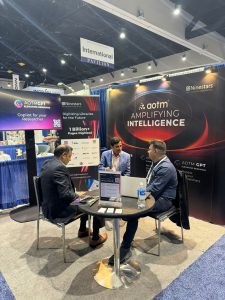The American Library Association’s (ALA) 2024 annual conference in San Diego was a resounding success. It brought together over 13,000 attendees, including librarians, library staff, authors, publishers, educators, and exhibitors from around the globe. Amidst the beautiful backdrop of palm trees and ocean breeze, participants gathered to discuss educational initiatives for libraries, attend insightful panels, and listen to inspiring guest speakers.
The conference featured a stellar lineup of speakers, including Trevor Noah, Taraji P. Henson, Ali Velshi, Max Greenfield, and other high-profile authors and advocates. Opening Session speaker Trevor Noah, best known as the host of the Emmy and Peabody Award-winning “The Daily Show” on Comedy Central, discussed his upcoming book, “Into the Uncut Grass,” set to release in October 2024. Academy Award-nominated actress, producer, author, and mental health advocate Taraji P. Henson spoke about her new book, “You Can Be a Good Friend (No Matter What!)” released on June 18, 2024. Additionally, Max Greenfield shared insights on his book, “Good Night Thoughts,” releasing in September 2024.
The conference was a whirlwind of activity, and we’re thrilled to share some highlights from this incredible weekend! One of the most rewarding aspects was reconnecting with our customers such as Clarivate, ITHAKA, NewsBank, and EBSCO. These long-time partners have been with us for years, and meeting them in such an inspiring setting like ALA was truly special. ITHAKA‘s showcase in the tech show was particularly fascinating, highlighting their latest innovations and contributions to the field.
We spent a considerable amount of time in the exhibition hall, where the sheer number of booths and exhibits was overwhelming. Even after several days, we left feeling like there was more to explore! The event featured over 175 educational programs created and curated by library professionals, more than 500 speakers and authors, and nearly 550 exhibitors. These programs covered a wide range of urgent topics facing libraries such as artificial intelligence, health and wellness, intellectual freedom, strategic partnerships, and justice-involved services.
We were particularly interested in sessions like “Breaking Boundaries: Harnessing the Power of Artificial Intelligence and ChatGPT to Transform Library Services” and “Demystifying AI for Business and Libraries,” which explored the transformative potential of technology in the library space.
At ALA, Ninestars proudly showcased AOTM, our suite of solutions designed to automate content and data processing environments with unmatched efficiency and precision. Visitors flocked to our booth (#2113) to discover our AI-powered automation solutions tailored for libraries and data-centric organizations. The excitement was palpable as attendees experienced firsthand how AOTM’s transformative AI and ML-powered solutions can streamline tasks and provide invaluable insights for smarter decision-making.
We showcased three key solutions: AOTM OCR, AOTM ICP, and AOTM GPT. AOTM OCR demonstrated its prowess in optical character recognition, while AOTM ICP impressed with its intelligent content processing capabilities. AOTM GPT, our custom-trainable GPT for large digital content repositories, sparked significant interest for its potential to revolutionize library operations. The positive feedback and enthusiasm from attendees were overwhelming, underscoring the impact of our innovative technology.
With over 25 years of expertise in digital content transformation, Ninestars has established global partnerships with esteemed organizations, including 13 national libraries and archives worldwide. We also collaborate with content aggregators, universities, and publishers in the United States and Europe. Our long-standing relationships with these partners are a testament to our commitment to excellence and innovation.
If you visited our booth, thank you! If we missed each other (we understand how packed the event can get), we still want to connect with you at a convenient time. We believe technology is a game-changer and would love to introduce you to AOTM and its benefits. Please drop us an email to arrange a meeting.
What were your takeaways from ALA? We look forward to hearing from you about the opportunities you see in applying advanced tech to propel your organization forward. Meanwhile, you can learn more about AOTM and Ninestars to get to know us better.


























